Unit 7 Business Law Assignment 1: Analysis of the Legal System and Law
VerifiedAdded on 2021/04/26
|34
|5017
|548
Report
AI Summary
This report provides a detailed analysis of the UK legal system, covering various aspects such as the definition of the legal system, its sources (internal and external), and the function of law within society. It differentiates between civil and criminal law, as well as statutory and common law, highlighting key differences and applications. The report further explores the justice system, including the role of government in law-making and the application of statutory and common law in courts. It also examines the court system's structure and the organization of judges. Furthermore, it evaluates recent reforms and developments within the legal system, such as the Money Claim Online and digital systems for possession cases, assessing their effectiveness. The report concludes by illustrating the potential impact of various laws, including company, employment, and contract law, on businesses, and differentiating between legislation, regulations, and standards to analyze their impact on business operations. The report also includes a critical evaluation of the legal system, supported by evidence from different relevant examples.
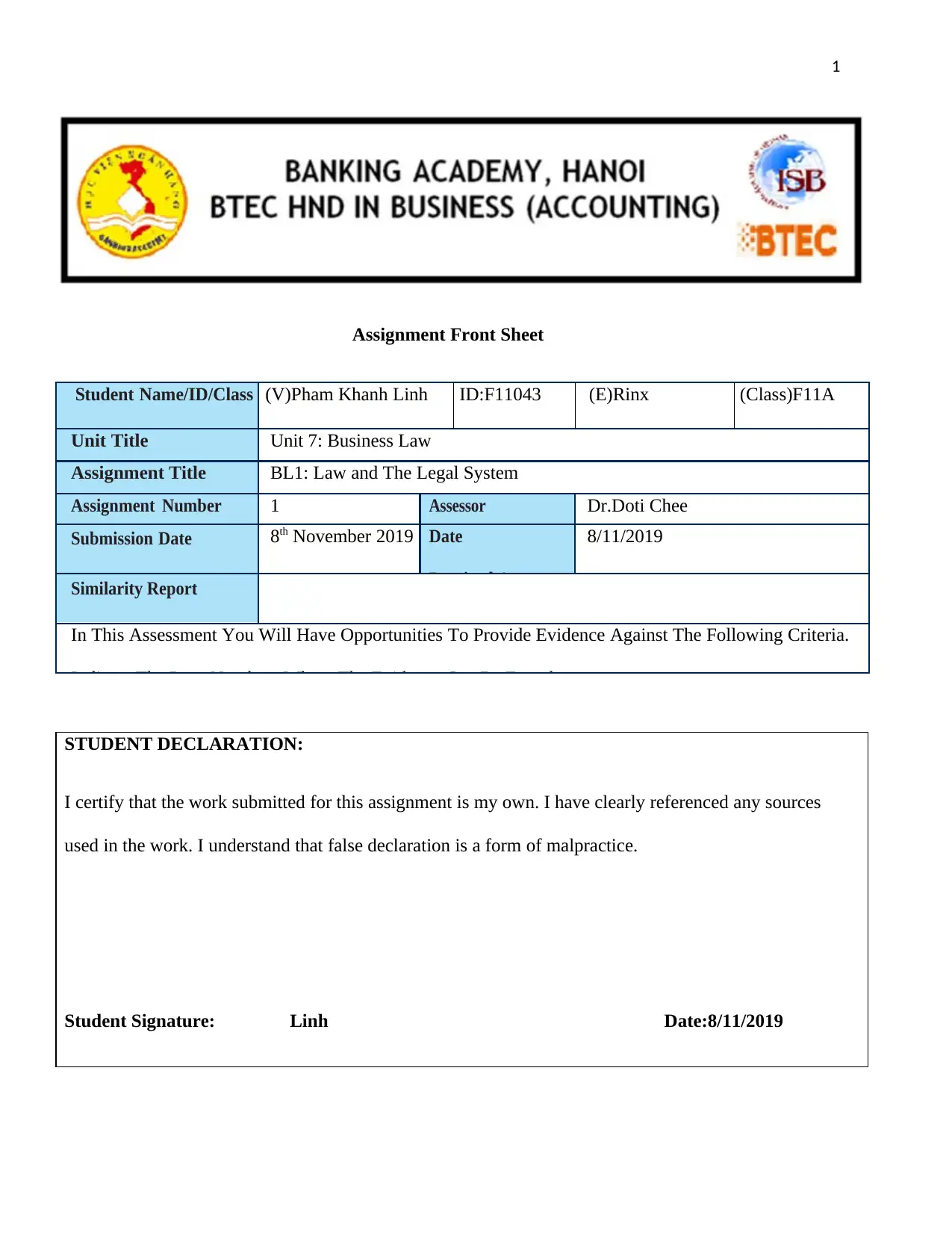
1
Assignment Front Sheet
Student Name/ID/Class (V)Pham Khanh Linh ID:F11043 (E)Rinx (Class)F11A
Unit Title Unit 7: Business Law
Assignment Title BL1: Law and The Legal System
Assignment Number 1 Assessor Dr.Doti Chee
Submission Date 8th November 2019 Date
Received 1st
8/11/2019
Similarity Report
In This Assessment You Will Have Opportunities To Provide Evidence Against The Following Criteria.
Indicate The Page Numbers Where The Evidence Can Be Found
STUDENT DECLARATION:
I certify that the work submitted for this assignment is my own. I have clearly referenced any sources
used in the work. I understand that false declaration is a form of malpractice.
Student Signature: Linh Date:8/11/2019
Assignment Front Sheet
Student Name/ID/Class (V)Pham Khanh Linh ID:F11043 (E)Rinx (Class)F11A
Unit Title Unit 7: Business Law
Assignment Title BL1: Law and The Legal System
Assignment Number 1 Assessor Dr.Doti Chee
Submission Date 8th November 2019 Date
Received 1st
8/11/2019
Similarity Report
In This Assessment You Will Have Opportunities To Provide Evidence Against The Following Criteria.
Indicate The Page Numbers Where The Evidence Can Be Found
STUDENT DECLARATION:
I certify that the work submitted for this assignment is my own. I have clearly referenced any sources
used in the work. I understand that false declaration is a form of malpractice.
Student Signature: Linh Date:8/11/2019
Paraphrase This Document
Need a fresh take? Get an instant paraphrase of this document with our AI Paraphraser
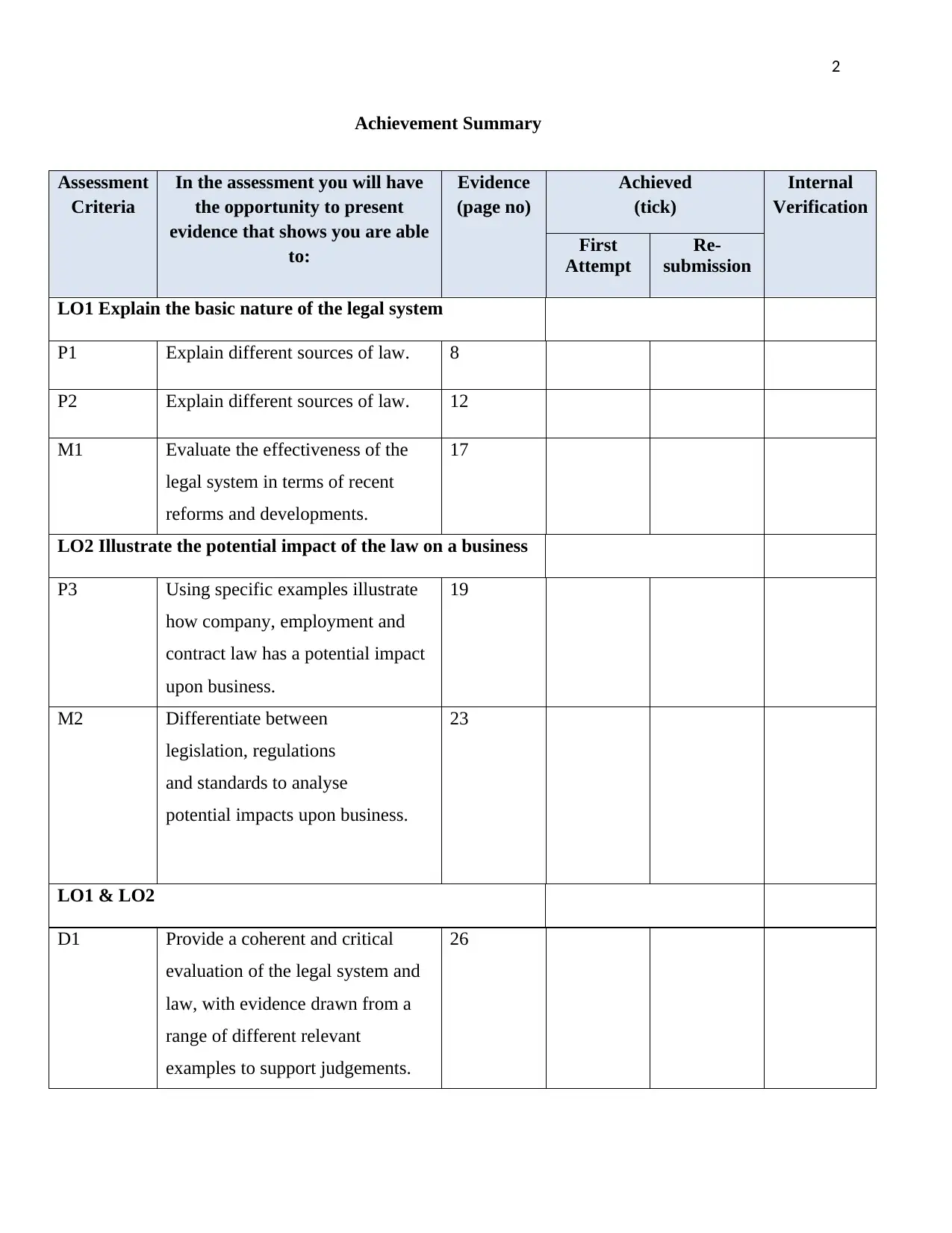
2
Achievement Summary
Assessment
Criteria
In the assessment you will have
the opportunity to present
evidence that shows you are able
to:
Evidence
(page no)
Achieved
(tick)
Internal
Verification
First
Attempt
Re-
submission
LO1 Explain the basic nature of the legal system
P1 Explain different sources of law. 8
P2 Explain different sources of law. 12
M1 Evaluate the effectiveness of the
legal system in terms of recent
reforms and developments.
17
LO2 Illustrate the potential impact of the law on a business
P3 Using specific examples illustrate
how company, employment and
contract law has a potential impact
upon business.
19
M2 Differentiate between
legislation, regulations
and standards to analyse
potential impacts upon business.
23
LO1 & LO2
D1 Provide a coherent and critical
evaluation of the legal system and
law, with evidence drawn from a
range of different relevant
examples to support judgements.
26
Achievement Summary
Assessment
Criteria
In the assessment you will have
the opportunity to present
evidence that shows you are able
to:
Evidence
(page no)
Achieved
(tick)
Internal
Verification
First
Attempt
Re-
submission
LO1 Explain the basic nature of the legal system
P1 Explain different sources of law. 8
P2 Explain different sources of law. 12
M1 Evaluate the effectiveness of the
legal system in terms of recent
reforms and developments.
17
LO2 Illustrate the potential impact of the law on a business
P3 Using specific examples illustrate
how company, employment and
contract law has a potential impact
upon business.
19
M2 Differentiate between
legislation, regulations
and standards to analyse
potential impacts upon business.
23
LO1 & LO2
D1 Provide a coherent and critical
evaluation of the legal system and
law, with evidence drawn from a
range of different relevant
examples to support judgements.
26
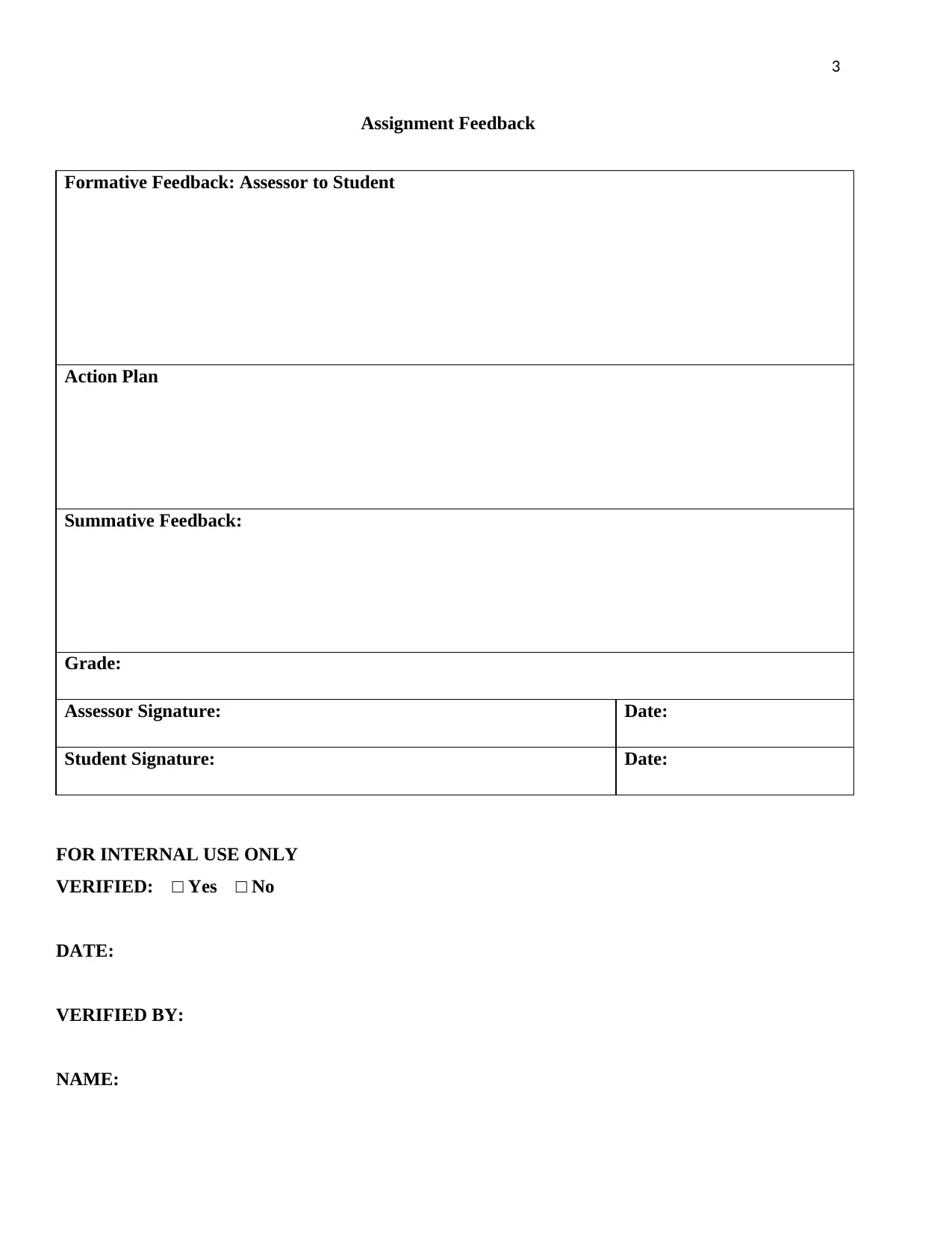
3
Assignment Feedback
Formative Feedback: Assessor to Student
Action Plan
Summative Feedback:
Grade:
Assessor Signature: Date:
Student Signature: Date:
FOR INTERNAL USE ONLY
VERIFIED: □ Yes □ No
DATE:
VERIFIED BY:
NAME:
Assignment Feedback
Formative Feedback: Assessor to Student
Action Plan
Summative Feedback:
Grade:
Assessor Signature: Date:
Student Signature: Date:
FOR INTERNAL USE ONLY
VERIFIED: □ Yes □ No
DATE:
VERIFIED BY:
NAME:
⊘ This is a preview!⊘
Do you want full access?
Subscribe today to unlock all pages.

Trusted by 1+ million students worldwide

4
Contents
I. Overall of Legal system..........................................................................................................5
1.1. Legal system........................................................................................................................6
1.1.1. Definition of UK legal system.........................................................................................6
1.1.2. The sources of law (P1)...................................................................................................8
- Internal sources of law...........................................................................................................8
- External sources of law..........................................................................................................8
1.1.3. The function of law.........................................................................................................9
1.1.4. Civil and criminal law...................................................................................................10
1.1.5. Statutory law and common law...................................................................................11
II. Justice System...................................................................................................................12
2.1. The role of government in law making process and how statutory law and common
law is applied in justice courts (P2)............................................................................................12
2.1.1. The role of government in law making process..............................................................12
The application of statutory law and common law in justice courts......................................13
2.2. Courts system and organization of judges..........................................................................14
2.2.1. Courts systems...................................................................................................................14
2.2.2. Organization of judiciary..................................................................................................16
2. Reform and development (M1)...........................................................................................16
3. The Potential impact of law upon business........................................................................19
3.1. The impact of various laws upon business (P3).............................................................19
Contents
I. Overall of Legal system..........................................................................................................5
1.1. Legal system........................................................................................................................6
1.1.1. Definition of UK legal system.........................................................................................6
1.1.2. The sources of law (P1)...................................................................................................8
- Internal sources of law...........................................................................................................8
- External sources of law..........................................................................................................8
1.1.3. The function of law.........................................................................................................9
1.1.4. Civil and criminal law...................................................................................................10
1.1.5. Statutory law and common law...................................................................................11
II. Justice System...................................................................................................................12
2.1. The role of government in law making process and how statutory law and common
law is applied in justice courts (P2)............................................................................................12
2.1.1. The role of government in law making process..............................................................12
The application of statutory law and common law in justice courts......................................13
2.2. Courts system and organization of judges..........................................................................14
2.2.1. Courts systems...................................................................................................................14
2.2.2. Organization of judiciary..................................................................................................16
2. Reform and development (M1)...........................................................................................16
3. The Potential impact of law upon business........................................................................19
3.1. The impact of various laws upon business (P3).............................................................19
Paraphrase This Document
Need a fresh take? Get an instant paraphrase of this document with our AI Paraphraser
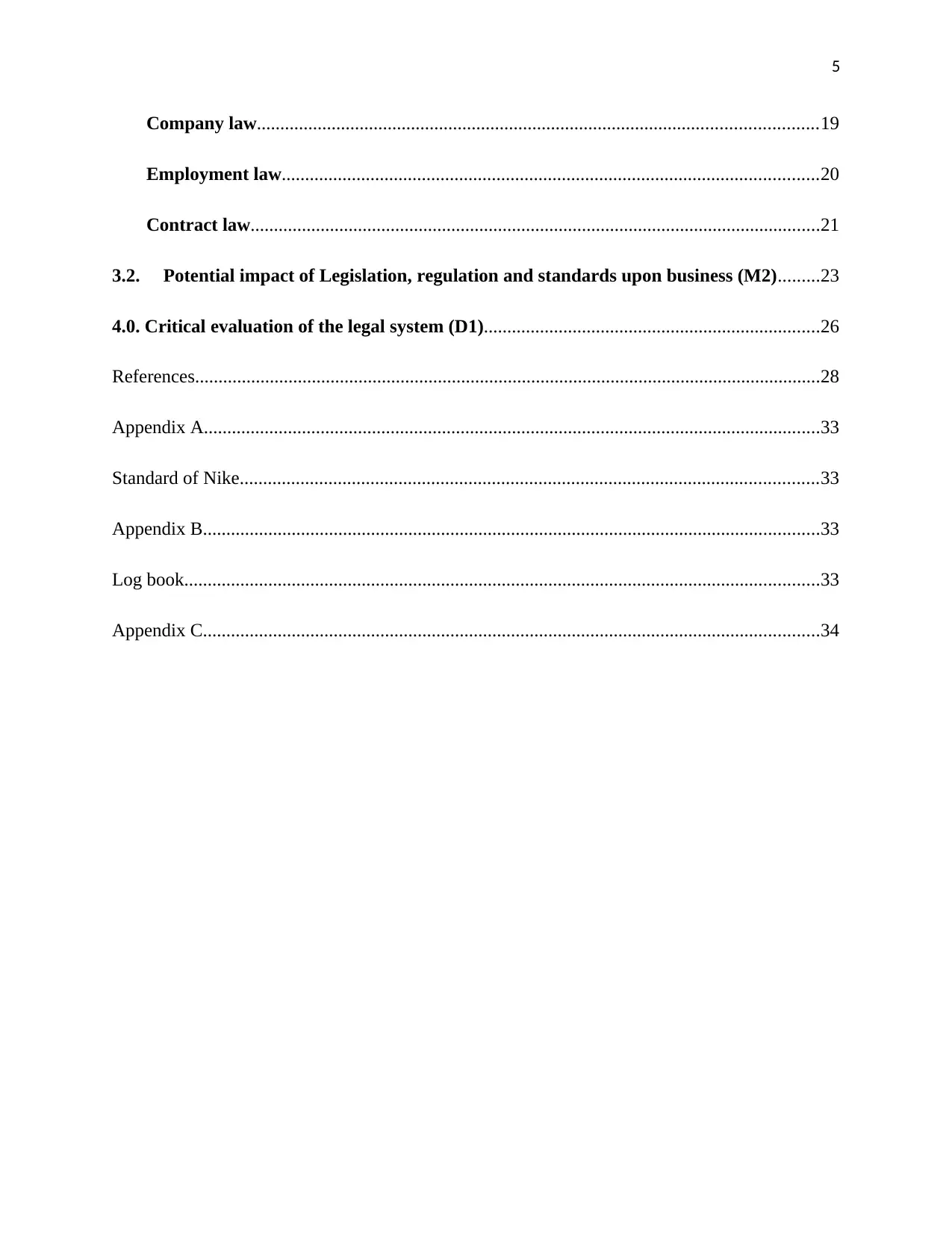
5
Company law........................................................................................................................19
Employment law...................................................................................................................20
Contract law..........................................................................................................................21
3.2. Potential impact of Legislation, regulation and standards upon business (M2).........23
4.0. Critical evaluation of the legal system (D1)........................................................................26
References......................................................................................................................................28
Appendix A....................................................................................................................................33
Standard of Nike............................................................................................................................33
Appendix B....................................................................................................................................33
Log book........................................................................................................................................33
Appendix C....................................................................................................................................34
Company law........................................................................................................................19
Employment law...................................................................................................................20
Contract law..........................................................................................................................21
3.2. Potential impact of Legislation, regulation and standards upon business (M2).........23
4.0. Critical evaluation of the legal system (D1)........................................................................26
References......................................................................................................................................28
Appendix A....................................................................................................................................33
Standard of Nike............................................................................................................................33
Appendix B....................................................................................................................................33
Log book........................................................................................................................................33
Appendix C....................................................................................................................................34
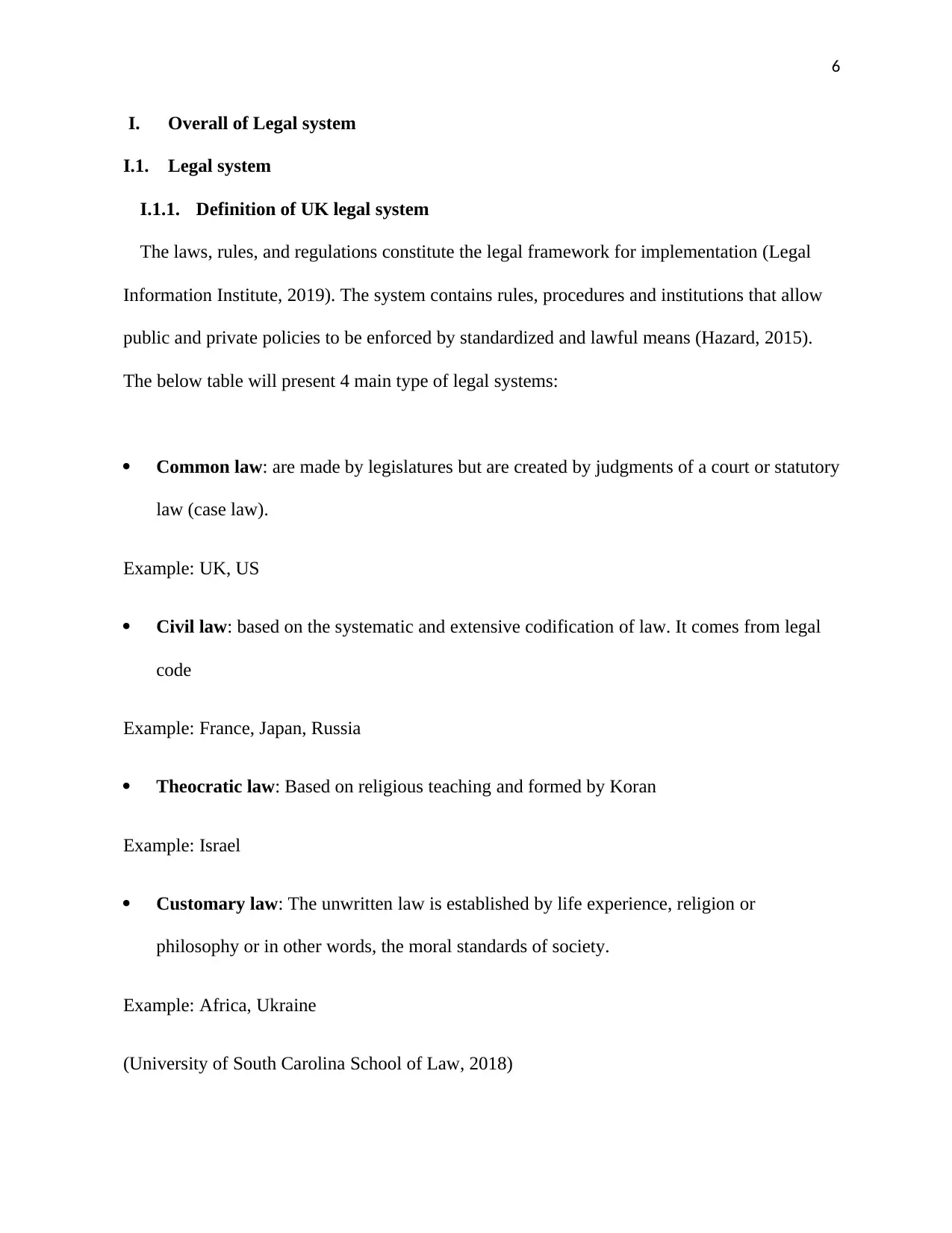
6
I. Overall of Legal system
I.1. Legal system
I.1.1. Definition of UK legal system
The laws, rules, and regulations constitute the legal framework for implementation (Legal
Information Institute, 2019). The system contains rules, procedures and institutions that allow
public and private policies to be enforced by standardized and lawful means (Hazard, 2015).
The below table will present 4 main type of legal systems:
Common law: are made by legislatures but are created by judgments of a court or statutory
law (case law).
Example: UK, US
Civil law: based on the systematic and extensive codification of law. It comes from legal
code
Example: France, Japan, Russia
Theocratic law: Based on religious teaching and formed by Koran
Example: Israel
Customary law: The unwritten law is established by life experience, religion or
philosophy or in other words, the moral standards of society.
Example: Africa, Ukraine
(University of South Carolina School of Law, 2018)
I. Overall of Legal system
I.1. Legal system
I.1.1. Definition of UK legal system
The laws, rules, and regulations constitute the legal framework for implementation (Legal
Information Institute, 2019). The system contains rules, procedures and institutions that allow
public and private policies to be enforced by standardized and lawful means (Hazard, 2015).
The below table will present 4 main type of legal systems:
Common law: are made by legislatures but are created by judgments of a court or statutory
law (case law).
Example: UK, US
Civil law: based on the systematic and extensive codification of law. It comes from legal
code
Example: France, Japan, Russia
Theocratic law: Based on religious teaching and formed by Koran
Example: Israel
Customary law: The unwritten law is established by life experience, religion or
philosophy or in other words, the moral standards of society.
Example: Africa, Ukraine
(University of South Carolina School of Law, 2018)
⊘ This is a preview!⊘
Do you want full access?
Subscribe today to unlock all pages.

Trusted by 1+ million students worldwide

7
The UK currently has three separate legal systems divided in 3 areas are England and
Wales (Common Law); Northern Ireland; Scotland.
The legislature in Parliament will consist of three components: the monarch, the upper
house and the lower house. The head of the legislature and executive branch in England and
Northern Ireland will be the queen (head of state). The Senate has 788 members of law who
function through laws and oversee the government's activities; discuss important issues of the
country. The House of Representatives consists of 650 parliamentarians who will be tasked with
passing the budget and overseeing government activities with two committees on common
affairs and a committee of experts (Ministry of Foreign Affairs, 2019).
The executive branch has a prime minister appointed by the queen and is passed by the
lower house. The Prime Minister will run the cabinet, proposing to the queen important positions
in the executive branch such as bishops or judges. Under the prime minister will be a cabinet
with 22-23 members appointed by the prime minister and the queen approved to include
ministers and vice ministers (Ministry of Foreign Affairs, 2019).
The UK currently has three separate legal systems divided in 3 areas are England and
Wales (Common Law); Northern Ireland; Scotland.
The legislature in Parliament will consist of three components: the monarch, the upper
house and the lower house. The head of the legislature and executive branch in England and
Northern Ireland will be the queen (head of state). The Senate has 788 members of law who
function through laws and oversee the government's activities; discuss important issues of the
country. The House of Representatives consists of 650 parliamentarians who will be tasked with
passing the budget and overseeing government activities with two committees on common
affairs and a committee of experts (Ministry of Foreign Affairs, 2019).
The executive branch has a prime minister appointed by the queen and is passed by the
lower house. The Prime Minister will run the cabinet, proposing to the queen important positions
in the executive branch such as bishops or judges. Under the prime minister will be a cabinet
with 22-23 members appointed by the prime minister and the queen approved to include
ministers and vice ministers (Ministry of Foreign Affairs, 2019).
Paraphrase This Document
Need a fresh take? Get an instant paraphrase of this document with our AI Paraphraser

8
I.1.2. The sources of law (P1)
- Internal sources of law
• Common law: Case law is considered the first law source due to the history of
the legal system. Cases and judgments that are objective, impartial and justice in
society can be exemplary to apply to similar cases later (Cilex.org.uk, 2019).
• Written law (statutory): Legislation includes laws, rules and regulations.
Legislative documents are the usual rules and regulations promulgated by the
parliament (Cilex.org.uk, 2019).
- External sources of law
EU Law: As a member of the EU, of course, following the rules of the union is
obvious. It is a form of international law but does not appear in international law.
For example, a person in European Union countries can sue for rights guaranteed
by EU law and international law will be required to be transformed into national
law before being applied (Dicey, 1915).
The European Convention on Human Rights: This international treaty is a
convention to protect human rights and political freedoms in Europe. The
Convention came into force in 1953 and included basic rights of human and
freedom (The Ministry of Justice, 2019)
I.1.2. The sources of law (P1)
- Internal sources of law
• Common law: Case law is considered the first law source due to the history of
the legal system. Cases and judgments that are objective, impartial and justice in
society can be exemplary to apply to similar cases later (Cilex.org.uk, 2019).
• Written law (statutory): Legislation includes laws, rules and regulations.
Legislative documents are the usual rules and regulations promulgated by the
parliament (Cilex.org.uk, 2019).
- External sources of law
EU Law: As a member of the EU, of course, following the rules of the union is
obvious. It is a form of international law but does not appear in international law.
For example, a person in European Union countries can sue for rights guaranteed
by EU law and international law will be required to be transformed into national
law before being applied (Dicey, 1915).
The European Convention on Human Rights: This international treaty is a
convention to protect human rights and political freedoms in Europe. The
Convention came into force in 1953 and included basic rights of human and
freedom (The Ministry of Justice, 2019)
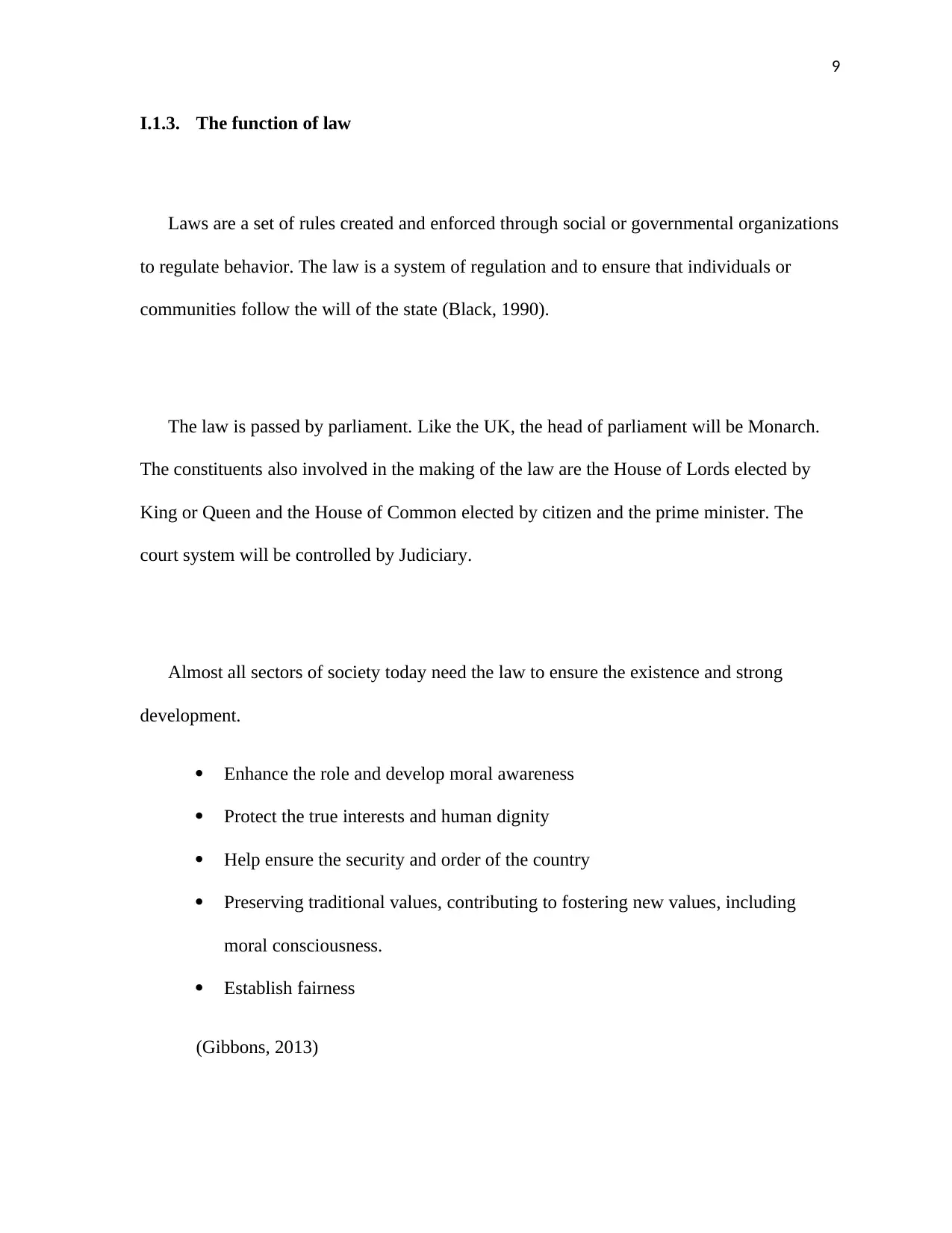
9
I.1.3. The function of law
Laws are a set of rules created and enforced through social or governmental organizations
to regulate behavior. The law is a system of regulation and to ensure that individuals or
communities follow the will of the state (Black, 1990).
The law is passed by parliament. Like the UK, the head of parliament will be Monarch.
The constituents also involved in the making of the law are the House of Lords elected by
King or Queen and the House of Common elected by citizen and the prime minister. The
court system will be controlled by Judiciary.
Almost all sectors of society today need the law to ensure the existence and strong
development.
Enhance the role and develop moral awareness
Protect the true interests and human dignity
Help ensure the security and order of the country
Preserving traditional values, contributing to fostering new values, including
moral consciousness.
Establish fairness
(Gibbons, 2013)
I.1.3. The function of law
Laws are a set of rules created and enforced through social or governmental organizations
to regulate behavior. The law is a system of regulation and to ensure that individuals or
communities follow the will of the state (Black, 1990).
The law is passed by parliament. Like the UK, the head of parliament will be Monarch.
The constituents also involved in the making of the law are the House of Lords elected by
King or Queen and the House of Common elected by citizen and the prime minister. The
court system will be controlled by Judiciary.
Almost all sectors of society today need the law to ensure the existence and strong
development.
Enhance the role and develop moral awareness
Protect the true interests and human dignity
Help ensure the security and order of the country
Preserving traditional values, contributing to fostering new values, including
moral consciousness.
Establish fairness
(Gibbons, 2013)
⊘ This is a preview!⊘
Do you want full access?
Subscribe today to unlock all pages.

Trusted by 1+ million students worldwide
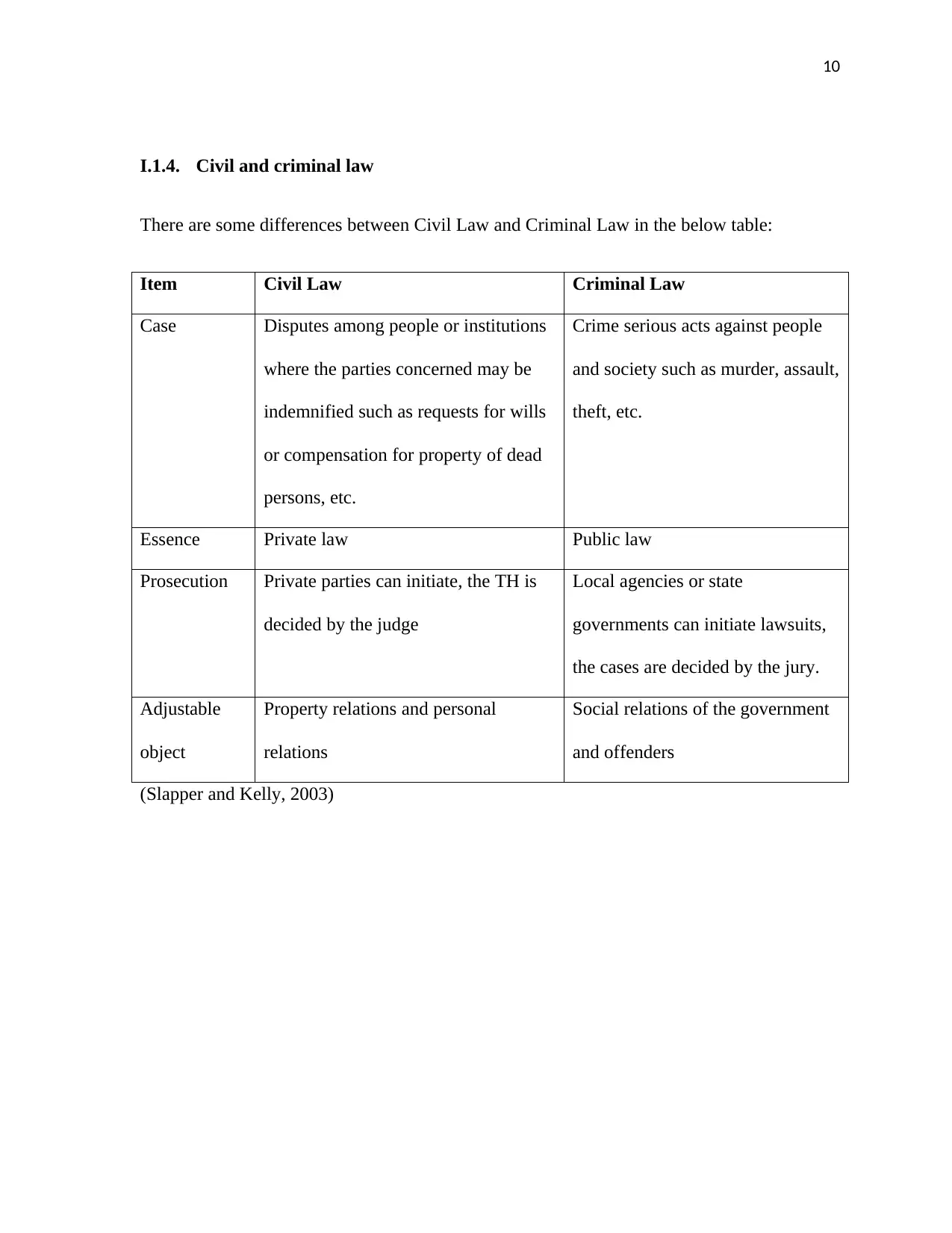
10
I.1.4. Civil and criminal law
There are some differences between Civil Law and Criminal Law in the below table:
Item Civil Law Criminal Law
Case Disputes among people or institutions
where the parties concerned may be
indemnified such as requests for wills
or compensation for property of dead
persons, etc.
Crime serious acts against people
and society such as murder, assault,
theft, etc.
Essence Private law Public law
Prosecution Private parties can initiate, the TH is
decided by the judge
Local agencies or state
governments can initiate lawsuits,
the cases are decided by the jury.
Adjustable
object
Property relations and personal
relations
Social relations of the government
and offenders
(Slapper and Kelly, 2003)
I.1.4. Civil and criminal law
There are some differences between Civil Law and Criminal Law in the below table:
Item Civil Law Criminal Law
Case Disputes among people or institutions
where the parties concerned may be
indemnified such as requests for wills
or compensation for property of dead
persons, etc.
Crime serious acts against people
and society such as murder, assault,
theft, etc.
Essence Private law Public law
Prosecution Private parties can initiate, the TH is
decided by the judge
Local agencies or state
governments can initiate lawsuits,
the cases are decided by the jury.
Adjustable
object
Property relations and personal
relations
Social relations of the government
and offenders
(Slapper and Kelly, 2003)
Paraphrase This Document
Need a fresh take? Get an instant paraphrase of this document with our AI Paraphraser
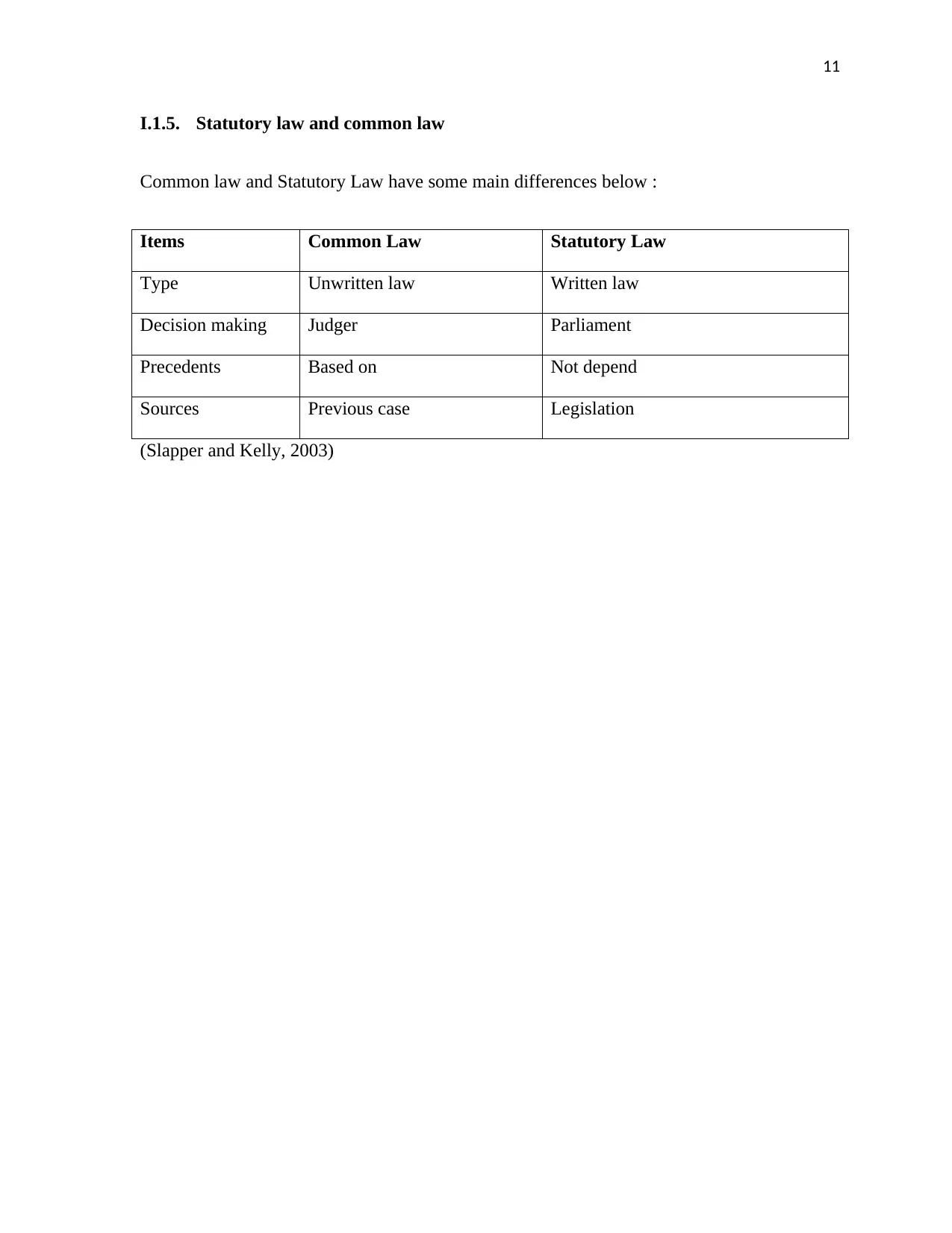
11
I.1.5. Statutory law and common law
Common law and Statutory Law have some main differences below :
Items Common Law Statutory Law
Type Unwritten law Written law
Decision making Judger Parliament
Precedents Based on Not depend
Sources Previous case Legislation
(Slapper and Kelly, 2003)
I.1.5. Statutory law and common law
Common law and Statutory Law have some main differences below :
Items Common Law Statutory Law
Type Unwritten law Written law
Decision making Judger Parliament
Precedents Based on Not depend
Sources Previous case Legislation
(Slapper and Kelly, 2003)

12
II. Justice System
II.1. The role of government in law making process and how statutory law and
common law is applied in justice courts (P2)
2.1.1. The role of government in law making process
Chart 1: The role of government in law-making process
(Zander, 2015)
II. Justice System
II.1. The role of government in law making process and how statutory law and
common law is applied in justice courts (P2)
2.1.1. The role of government in law making process
Chart 1: The role of government in law-making process
(Zander, 2015)
⊘ This is a preview!⊘
Do you want full access?
Subscribe today to unlock all pages.

Trusted by 1+ million students worldwide
1 out of 34
Related Documents
Your All-in-One AI-Powered Toolkit for Academic Success.
+13062052269
info@desklib.com
Available 24*7 on WhatsApp / Email
![[object Object]](/_next/static/media/star-bottom.7253800d.svg)
Unlock your academic potential
Copyright © 2020–2025 A2Z Services. All Rights Reserved. Developed and managed by ZUCOL.





